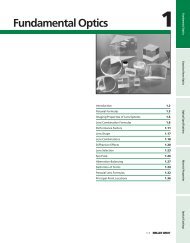Intel PXA250 and PXA210 Applications Processors
Intel PXA250 and PXA210 Applications Processors
Intel PXA250 and PXA210 Applications Processors
You also want an ePaper? Increase the reach of your titles
YUMPU automatically turns print PDFs into web optimized ePapers that Google loves.
SA-1110/<strong>Applications</strong> Processor Migration<br />
A.3.1<br />
<strong>Intel</strong>® XScale Microarchitecture<br />
The <strong>PXA250</strong> applications processor is a system on a chip that includes <strong>Intel</strong>’s new microprocessor<br />
megacell. This includes <strong>Intel</strong>® Superpipelined Technology <strong>and</strong> a new optimized cache<br />
architecture that allows program execution to continue despite data cache misses.<br />
The <strong>PXA250</strong> applications processor supports:<br />
• ARM* Architecture v5 instructions, including ARM’s Thumb extensions<br />
• DSP Extensions but not ARM’s optional Vector Floating Point instructions<br />
Appendix A in the <strong>Intel</strong> 80200 Developers’ manual, Order# 273411-002 [http://<br />
developer.intel.com], is the best guide to the new capabilities available in the <strong>Intel</strong>® XScale<br />
Megacell's Instruction Set.<br />
Using a software development toolset that takes specific advantage of <strong>Intel</strong>® XScale<br />
microarchitecture, <strong>and</strong> <strong>Intel</strong>® Media Processing Technology could give you substantial<br />
performance benefits.<br />
The <strong>PXA250</strong> applications processor offers increased performance at similar clock rates, <strong>and</strong> also a<br />
wider range of operating clock rates at lower voltages. The overall benefit is more work done for<br />
less battery power.<br />
A.3.2<br />
Debugging<br />
New <strong>PXA250</strong> hardware creates new debugging possibilities. You can use the JTAG test port to<br />
download programs into a dedicated memory area to act as a debug monitor. <strong>Applications</strong> can be<br />
inspected <strong>and</strong> performance data, such as cache hit rates, can be measured via a dialog over JTAG.<br />
These features offer developers far more visibility inside a <strong>PXA250</strong> system improving time to<br />
market.<br />
A.3.3<br />
Cache Attributes<br />
The <strong>PXA250</strong> applications processor has twice the instruction cache <strong>and</strong> four times the data cache<br />
of the SA-1110. The Caches can be locked for optimized code or data <strong>and</strong> for reliability the caches<br />
are now covered by parity protection.<br />
To take advantage of cache locking software, data must be selected <strong>and</strong> specifically loaded <strong>and</strong><br />
locked into cache.<br />
To take advantage of new features such as Write-Through mode for external IO buffers, page tables<br />
will need to be revisited in boot software.<br />
A.3.4<br />
Other features<br />
As mentioned before, the <strong>PXA250</strong> DMA controller is highly versatile. With 16 channels it can be<br />
utilized as:<br />
• Several serial ports in parallel<br />
• A general-purpose memory move capability<br />
• A fast interface for external companion devices<br />
A-8 <strong>PXA250</strong> <strong>and</strong> <strong>PXA210</strong> <strong>Applications</strong> <strong>Processors</strong> Design Guide
















